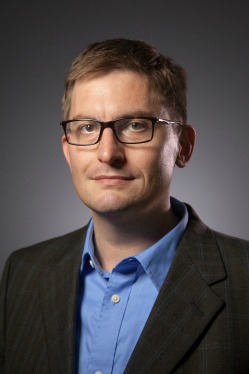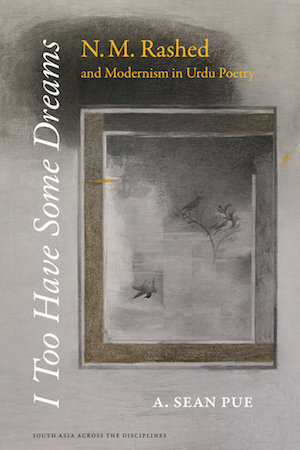A. Sean Pue
|
A. Sean Pue has a PhD in comparative literature from Columbia and heads the Urdu-Hindi program at Michigan State University. Here he talks about his discovery of Urdu poetry, and his love for the work of avant-garde Pakistani poet NM Rashed
TFT: Tell us about your education and family background.Gaye Dinon ASP: I was born and raised in San Diego, California, which is at the southwestern corner of the United States. My mother is from Ireland, and my father is from Canada and of Northern Irish descent. I attended the University of California, Berkeley where I double majored in South Asian Studies and Religious Studies. In 1997-98, I studied Urdu in Lahore on the Berkeley Urdu Language Program in Pakistan (BULPIP), which is unfortunately now suspended but had trained a number of generations of American Urdu scholars. I then went on to Columbia University where a completed an MA and then a PhD in Middle East and Asian Languages and Cultures and in Comparative Literature and Society in 2007. My primary advisor was Frances Pritchett, a world-renowned Urdu literary historian. I then had a postdoctoral appointment at the University of Chicago at the South Asian Language Resource Center, where I helped to facilitate the development of South Asian language teaching materials using digital technology and also taught a couple of Hindi and Urdu advanced literature classes. I then began as Assistant Professor of Hindi language and South Asian literature and culture at Michigan State University in East Lansing, MI. There I run the Hindi and Urdu language programs, teach in the humanities core curriculum, and am a core faculty member in an innovative Global Studies in Arts and Humanities program. TFT: How did you become interested in Hindi/Urdu? ASP: When I started at Berkeley, I intended to study cognitive science. I found that topic to be a bit too quantitative, and I did not want to be stuck behind a desk staring at a computer screen all day. Like many of us, I haven’t entirely escaped that fate. I decided to take a few introductory South Asian studies classes. I enjoyed them and did well in them, and my professors suggested that I take classes with a new professor by the name of Aditya Behl, who had recently joined the faculty and was finishing up his dissertation from the University of Chicago on Hindavi romances. He passed away recently, at a young age, which has been a real tragedy to his colleagues and students. He was clearly one of the brightest minds of his generation and had a staggering control over South Asian languages and literature. I enrolled in his Religious Identities in South Asia class, which started out with about forty students but within a week had whittled down to three of us. The reading load was quite hefty. He introduced me to Indo-Muslim cultural history and sparked my interest in Hindi and Urdu, as well as academia. I believe I took eight or nine classes from him, including a first-year Hindi language summer course. I also took my first Urdu class from him after a second year of Hindi. It was really rather painful. We learned the Urdu script and then launched into reading Mirza Shauq’s masnavi Zahr-e Ishq. Aditya Behl encouraged me to work with Frances Pritchett at Columbia, and I received a fellowship there. I also applied for the Berkeley Urdu Language Program, and I was able to defer entering graduate school for a year in order to study Urdu in Lahore.
ASP: I was not necessarily planning to work on literature when I applied for graduate school. History has really been one of the more innovative fields in the study of South Asia, and I developed an interest in the critique of colonial knowledge as well as in critical theory in general as an undergraduate. I was already hooked on Urdu literature, however, and I had grown more and more interested in Urdu poetry when I was in Lahore. Then I went to Columbia and studied with Frances Pritchett, which sealed my fate, as she is amazingly adept at reading literary texts and in conveying her passion for Urdu. By temperament, I am much better at responding to objects than in producing historical narratives, so literary criticism is a much better fit for me personally. However, I do read literary texts historically as part of a larger discourse, while remaining attuned to their formal qualities. The study of South Asian literature in the United States has been in something of a slump for a number of years, as the critique of Cold War area studies as well as of philology has left many literary critics cowering in fear or focusing exclusively on the English-language colonial archive. I think we are now seeing a resurgence of literary scholarship that takes seriously the critique of Orientalism while still maintaining the philological mastery needed for advanced research. TFT: Why did you choose NM Rashed? ASP: When I started the MA/PhD program at Columbia, I was not sure exactly what to do work on. Frances Pritchett recommended working on Urdu masnavi, which I began to research. When I read Rashed’s desert poems in her Modern Urdu Poetry class I decided that his poetry would be a better topic. While I found his poetry very difficult to understand, I had a very strong aesthetic reaction to it. I had also become very interested in Iran and Persian literature under the influence of the eminent Persian scholar Hamid Dabashi, with whom I was reading Rumi at the time. Somewhere in the midst of Rashed’s “Dil mire sahranavard-e pir dil” there is also mention of the “complaints of the reed” (shikhvah-ha-e nai), and Rashed’s language itself seemed to me to be very influenced by modern Persian. Also, his second volume is about his experiences as a soldier in the British Indian Army in Iran during World War II, and he translated and researched modern Persian poetry. Rashed’s poetry also resonated with my interests in critical and postcolonial theory, and he has a lot to say about the relationship between nature and history as well as about colonialism and imperialism. So I wound up writing my master’s thesis and then Ph.D. thesis on N. M. Rashed and modern Urdu poetry. After 9/11, I was not able to activate any of the dissertation research fellowships I received to do work in Pakistan, so I spent a year working in India, where I was affiliated with the Urdu department at Jamia Millia Islamia in Delhi. I talked with many Urdu critics in India and also worked through archives of literary journals, as well as Rashed’s poetry. I am still interested in the topic after these many years, so it was a good choice, and it has also opened up a number of new directions for my future research. TFT: What are you working on now? ASP: I am now working on revising my dissertation into a book. I also have a number of articles related to this project coming out in academic journals. I have come to Pakistan on an American Institute of Pakistan Studies fellowship to do some final research here and give a few lectures. I was invited by Dr. Nomanul Haq and Salima Hashmi to give a lecture at the Faiz centenary conference at LUMS, and so I came in February. A revised version of that paper will be published in Bunyaad, the Urdu research journal of LUMS. I have also been meeting with critics and writers and gathering the excellent materials released in relation to Rashed’s 100th birth anniversary last year. TFT: Why did NM Rashed not become a popular poet like Faiz? ASP: Rashed’s poetry can be a bit tough to understand at times. Although it addresses social themes, Faiz’s poetry still more readily conforms to the stereotypes of what Urdu poetry should be. Rashed, by contrast, was very concerned with breaking with what he considered to be the worn-out symbols and metaphors of classical poetry. Rashed’s first volume, Mavara, was quite popular or perhaps infamous, as it broke with poetic conventions of both form and content. His second, Iran Men Ajnabi, is actually very embedded in the political and historical situation in Iran, and needs a certain amount of context in order to make sense of much of it. The later volumes, La=Insanand Guman Ka Mumkin,lack the obvious historical specificity of the Iran poems and have been frequently dismissed as excessively internal. Some see this as a product of Rashed’s distance from his nation, since they were composed mostly abroad when he was working for the United Nations. But I argue that his later diasporic poems work allegorically, by taking elements from Urdu literary tradition and placing them in new contexts. In the process, they both destabilize established meanings and produce new ones. Rashed has been called a “poet’s poet,” but that’s not necessarily always the case. Poems such as “Zindagi se darte ho” and “Hasan Kuzagar” are quite accessible and extremely popular. I was recently informed that certain lines of the former were circulating via text messaging during a recent regime change, and the latter is frequently held up as a perennial poem for understanding the relationship between love and creativity. There was a great deal of new scholarship produced last year, and I have collected and read through around ten new volumes on his poetry. Rashed’s poetry remains intriguing and his voice is still very powerful. There is obviously a great deal of interest in Rashed, including among the younger generations. I recently met someone who is working on a video documentary on Rashed’s life and works. I hope my book will also open up some new perspectives on Rashed’s poetry. At the same time, I am also trying to form a bridge between more specific Urdu literary questions and wider academic concerns about poetry, postcolonialism, and global modernism, exposing Urdu literature to a wider audience while also addressing global concerns to Urdu literature.
Nazar Muhammad Rashed (1910 – 1975) – نذرِ مُحَمَّد راشِد |

 Birth—
Birth—